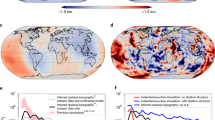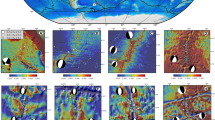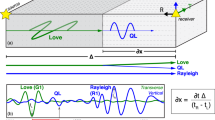Abstract
Convective circulation of the Earth’s mantle maintains some fraction of surface topography that varies with space and time. Most predictive models show that this dynamic topography has peak amplitudes of about ±2 km, dominated by wavelengths of 104 km. Here, we test these models against our comprehensive observational database of 2,120 spot measurements of dynamic topography that were determined by analysing oceanic seismic surveys. These accurate measurements have typical peak amplitudes of ±1 km and wavelengths of approximately 103 km, and are combined with limited continental constraints to generate a global spherical harmonic model, the robustness of which has been carefully tested and benchmarked. Our power spectral analysis reveals significant discrepancies between observed and predicted dynamic topography. At longer wavelengths (such as 104 km), observed dynamic topography has peak amplitudes of about ±500 m. At shorter wavelengths (such as 103 km), significant dynamic topography is still observed. We show that these discrepancies can be explained if short-wavelength dynamic topography is generated by temperature-driven density anomalies within a sub-plate asthenospheric channel. Stratigraphic observations from adjacent continental margins show that these dynamic topographic signals evolve quickly with time. More rapid temporal and spatial changes in vertical displacement of the Earth’s surface have direct consequences for fields as diverse as mantle flow, oceanic circulation and long-term climate change.
This is a preview of subscription content, access via your institution
Access options
Subscribe to this journal
Receive 12 print issues and online access
$259.00 per year
only $21.58 per issue
Buy this article
- Purchase on Springer Link
- Instant access to full article PDF
Prices may be subject to local taxes which are calculated during checkout






Similar content being viewed by others
Change history
13 May 2016
In the version of the Article originally published, the link in the 'Data and code sources' section of the Methods was incorrect and should have been 'ftp://bullard.esc.cam.ac.uk/pub/incoming/mjh217'. This has been corrected in all versions of the Article.
09 June 2016
In the version of the Article corrected on 13 May 2016, the location of the data accessed via the link provided in the 'Data and code sources' section of the Methods proved unsuitable. The link has now been removed and the isostatic and spherical harmonic inversion codes are available on request from the corresponding authors. This information has been corrected in the online versions of the Article.
References
Pekeris, C. L. Thermal convection in the interior of the Earth. Geophys. Suppl. Mon. Not. R. Astron. Soc. 3, 343–367 (1935).
Turcotte, D. L. & Schubert, G. Geodynamics 2nd edn (Cambridge Univ. Press, 2002).
Richards, M. A. & Hager, B. H. Geoid anomalies in a dynamic Earth. J. Geophys. Res. 89, 5987–6002 (1984).
Hager, B. H., Clayton, R. W. & Richards, M. A. Lower mantle heterogeneity, dynamic topography and the geoid. Nature 313, 541–545 (1985).
Schuberth, B. S. A. & Bunge, H. P. Tomographic filtering of high-resolution mantle circulation models: can seismic heterogeneity be explained by temperature alone? Geochem. Geophys. Geosyst. 10, Q05W03 (2009).
Davies, D. R. et al. Reconciling dynamic and seismic models of Earth’s lower mantle: the dominant role of thermal heterogeneity. Earth Planet. Sci. Lett. 353–354, 253–269 (2012).
Steinberger, B. Effects of latent heat release at phase boundaries on flow in the Earth’s mantle, phase boundary topography and dynamic topography at the Earth’s surface. Phys. Earth Planet. Inter. 164, 2–20 (2007).
Conrad, C. P. & Husson, L. Influence of dynamic topography on sea level and its rate of change. Lithosphere 1, 110–120 (2009).
Ricard, Y., Richards, M. A., Lithgow-Bertelloni, C. & Le Stunff, Y. A geodynamic model of mantle density heterogeneity. J. Geophys. Res. 98, 21895–21909 (1993).
Flament, N., Gurnis, M. & Müller, R. D. A review of observations and models of dynamic topography. Lithosphere 5, 189–210 (2013).
Moucha, R. et al. Dynamic topography and long-term sea-level variations: there is no such thing as a stable continental platform. Earth Planet. Sci. Lett. 271, 101–108 (2008).
Bunge, H. P., Hagelberg, C. R. & Travis, B. J. Mantle circulation models with variational data assimilation: inferring past mantle flow and structure from plate motion histories and seismic tomography. Geophys. J. Int. 152, 280–301 (2003).
Spasojević, S. & Gurnis, M. Sea level and vertical motion of continents from dynamic earth models since the Late Cretaceous. AAPG Bull. 96, 2037–2064 (2012).
Crosby, A. G., McKenzie, D. P. & Sclater, J. G. The relationship between depth, age and gravity in the oceans. Geophys. J. Int. 166, 553–573 (2006).
Menard, H. W. Depth anomalies and the bobbing motion of drifting islands. J. Geophys. Res. 78, 5128–5137 (1973).
Müller, R. D., Sdrolias, M., Gaina, C. & Roest, W. R. Age, spreading rates, and spreading asymmetry of the world’s ocean crust. Geochem. Geophys. Geosyst. 9, Q04006 (2008).
White, R. S., McKenzie, D. P. & O’Nions, R. K. Oceanic crustal thickness from seismic measurements and rare earth element inversions. J. Geophys. Res. 97, 19683–19715 (1992).
Winterbourne, J. R., Crosby, A. G. & White, N. J. Depth, age and dynamic topography of oceanic lithosphere beneath heavily sedimented Atlantic margins. Earth Planet. Sci. Lett. 287, 137–151 (2009).
Czarnota, K., Hoggard, M. J., White, N. J. & Winterbourne, J. Spatial and temporal patterns of Cenozoic dynamic topography around Australia. Geochem. Geophys. Geosyst. 14, 634–658 (2013).
Winterbourne, J. R., White, N. J. & Crosby, A. G. Accurate measurements of residual topography from the oceanic realm. Tectonics 33, 1–34 (2014).
Crosby, A. G. & McKenzie, D. P. An analysis of young ocean depth, gravity and global residual topography. Geophys. J. Int. 178, 1198–1219 (2009).
Hohertz, W. L. & Carlson, R. L. An independent test of thermal subsidence and asthenosphere flow beneath the Argentine Basin. Earth Planet. Sci. Lett. 161, 73–83 (1998).
Jackson, M. P. A., Hudec, M. R. & Hegarty, K. A. The great West African Tertiary coastal uplift: fact or fiction? A perspective from the Angolan divergent margin. Tectonics 24, TC6014 (2005).
Guiraud, M., Buta-Neto, A. & Quesne, D. Segmentation and differential post-rift uplift at the Angola margin as recorded by the transform-rifted Benguela and oblique-to-orthogonal-rifted Kwanza basins. Mar. Petrol. Geol. 27, 1040–1068 (2010).
Roberts, G. G. & White, N. J. Estimating uplift rate histories from river profiles using African examples. J. Geophys. Res. 115, B02406 (2010).
Smith, W. H. F. & Sandwell, D. T. Global sea floor topography from satellite altimetry and ship depth soundings. Science 277, 1956–1962 (1997).
Divins, D. L. Total Sediment Thickness of the World’s Oceans and Marginal Seas (NOAA National Geophysical Data Center, 2003).
Laske, G. & Masters, G. A global digital map of sediment thickness. EOS Trans. Am. Geophys. Union 78, F483 (1997).
Jordan, T. H. The continental tectosphere. Rev. Geophys. 13, 1–12 (1975).
Tapley, B. et al. The GGM03 mean Earth gravity model from GRACE. Eos Trans. Am. Geophys. Union 88, abstr. G42A-03 (2007).
McKenzie, D. P. The influence of dynamically supported topography on estimates of Te. Earth Planet. Sci. Lett. 295, 127–138 (2010).
Colli, L., Ghelichkhan, S. & Bunge, H.-P. On the ratio of dynamic topography and gravity anomalies in a dynamic Earth. Geophys. Res. Lett. 43, 2510–2516 (2016).
Wilson, J. W. P., Roberts, G. G., Hoggard, M. J. & White, N. J. Cenozoic epeirogeny of the Arabian Peninsula from drainage modeling. Geochem. Geophys. Geosyst. 15, 3723–3761 (2014).
Stephenson, S. N., Roberts, G. G., Hoggard, M. J. & Whittaker, A. C. A Cenozoic uplift history of Mexico and its surroundings from longitudinal river profiles. Geochem. Geophys. Geosyst. 15, 4734–4758 (2014).
Czarnota, K., Roberts, G. G., White, N. J. & Fishwick, S. Spatial and temporal patterns of Australian dynamic topography from river profile modeling. J. Geophys. Res. 119, 1384–1424 (2014).
Hager, B. H. & Richards, M. A. Long-wavelength variations in Earth’s geoid: physical models and dynamical implications. Phil. Trans. R. Soc. Lond. A 328, 309–327 (1989).
Steinberger, B., Werner, S. C. & Torsvik, T. H. Deep versus shallow origin of gravity anomalies, topography and volcanism on Earth, Venus and Mars. Icarus 207, 564–577 (2010).
Forte, A. M. Constraints on seismic models from other disciplines—implications for mantle dynamics and composition. Treat. Geophys. 1, 805–858 (2007).
Cazenave, A., Souriau, A. & Dominh, K. Global coupling of Earth surface topography with hotspots, geoid and mantle heterogeneities. Nature 340, 54–57 (1989).
Wen, L. & Anderson, D. L. Layered mantle convection: a model for geoid and topography. Earth Planet. Sci. Lett. 146, 367–377 (1997).
Delorey, A. A., Dunn, R. A. & Gaherty, J. B. Surface wave tomography of the upper mantle beneath the Reykjanes Ridge with implications for ridge hot spot interaction. J. Geophys. Res. 112, B08313 (2007).
Rickers, F., Fichtner, A. & Trampert, J. The Iceland-Jan Mayen plume system and its impact on mantle dynamics in the North Atlantic region: evidence from full-waveform inversion. Earth Planet. Sci. Lett. 367, 39–51 (2013).
Yale, M. M. & Morgan, J. P. Asthenosphere flow model of hotspot-ridge interactions: a comparison of Iceland and Kerguelen. Earth Planet. Sci. Lett. 161, 45–56 (1998).
Hartley, R. A., Roberts, G. G., White, N. & Richardson, C. Transient convective uplift of an ancient buried landscape. Nature Geosci. 4, 562–565 (2011).
Fichtner, A., Kennett, B. L. N., Igel, H. & Bunge, H.-P. Full seismic waveform tomography for upper-mantle structure in the Australasian region using adjoint methods. Geophys. J. Int. 179, 1703–1725 (2009).
French, S., Lekic, V. & Romanowicz, B. Waveform tomography reveals channeled flow at the base of the oceanic asthenosphere. Science 342, 227–231 (2013).
Dalton, C. A., Langmuir, C. H. & Gale, A. Geophysical and geochemical evidence for deep temperature variations beneath mid-ocean ridges. Science 344, 80–83 (2014).
Buck, W. R., Small, C. & Ryan, W. B. F. Constraints on asthenospheric flow from the depths of oceanic spreading centers: the East Pacific Rise and the Australian-Antarctic discordance. Geochem. Geophys. Geosyst. 10, Q09007 (2009).
Weismüller, J. et al. Fast asthenosphere motion in high-resolution global mantle flow models. Geophys. Res. Lett. 42, 7429–7435 (2015).
Priestley, K. & McKenzie, D. P. The relationship between shear wave velocity, temperature, attenuation and viscosity in the shallow part of the mantle. Earth Planet. Sci. Lett. 381, 78–91 (2013).
Ritsema, J., Deuss, A., van Heijst, H. J. & Woodhouse, J. H. S40RTS: a degree-40 shear-velocity model for the mantle from new Rayleigh wave dispersion, teleseismic traveltime and normal-mode splitting function measurements. Geophys. J. Int. 184, 1223–1236 (2011).
Acknowledgements
This research was supported by a BP-Cambridge collaboration. We are grateful to ION for permission to publish partial seismic reflection profiles shown in Fig. 2 from their IndiaSPAN and Greater BrasilSPAN data sets. We thank J. Austermann, P. Bellingham, J. Braun, R. Buck, A. Bump, H.-P. Bunge, R. Corfield, A. Crosby, K. Czarnota, M. Falder, A. Forte, I. Frame, S. Ghelichkhan, D. Glassey, T. Heyn, B. Horn, S. Kisin, D. Lyness, L. Mackay, K. McDermott, D. McKenzie, R. Parnell-Turner, F. Richards, G. Roberts, B. Schuberth, B. Steinberger, E. Stirling, M. Thompson, J. Weismüller, J. Wilson and J. Winterbourne for their help. Figures were prepared using Generic Mapping Tools and routines from the SHTOOLS package were used in the spherical harmonic analysis. Earth Sciences contribution esc.3605.
Author information
Authors and Affiliations
Contributions
This project was conceived and managed by N.W.; M.J.H. processed, interpreted and modelled the databases with guidance from N.W. and D.A.-A. The paper was written by all three authors.
Corresponding authors
Ethics declarations
Competing interests
The authors declare no competing financial interests.
Supplementary information
Supplementary Information
Supplementary Information (PDF 23763 kb)
Supplementary Information
Supplementary Information (ZIP 2785 kb)
Rights and permissions
About this article
Cite this article
Hoggard, M., White, N. & Al-Attar, D. Global dynamic topography observations reveal limited influence of large-scale mantle flow. Nature Geosci 9, 456–463 (2016). https://doi.org/10.1038/ngeo2709
Received:
Accepted:
Published:
Issue Date:
DOI: https://doi.org/10.1038/ngeo2709
This article is cited by
-
Antarctic Peninsula glaciation patterns set by landscape evolution and dynamic topography
Nature Geoscience (2024)
-
Geodynamics of continental rift initiation and evolution
Nature Reviews Earth & Environment (2023)
-
Caribbean plate tilted and actively dragged eastwards by low-viscosity asthenospheric flow
Nature Communications (2021)
-
The deep thermal structure of the lithosphere in the northwestern South China Sea and its control on the shallow tectonics
Science China Earth Sciences (2021)
-
The elusive mantle dynamic topography
Science China Earth Sciences (2020)



